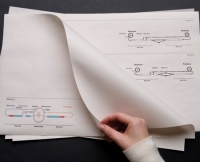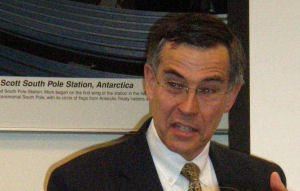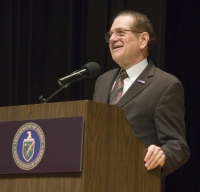From symmetry Magazine: Evolution of a Collider
As physicists and engineers devise ways to make the International Linear Collider perform better at a lower cost, the design evolves, sometimes with tweaks but at other times with major reconfigurations.

(Image courtesy of Fermilab) |
Designing the International Linear Collider is an evolutionary process. The ILC would be a next-generation machine that smashes together electrons and their opposites, positrons, to unlock some of the deepest mysteries about the universe. But aside from the new science, the ILC enters new territory in terms of planning and designing for the particle-physics community.
Read more...
-- Elizabeth Clements |
|
 |
U.S. Congressmen Address ILC R&D and Industrialisation
Last week on 28 February, U.S. industry members and scientists gathered at the Linear Collider Forum of America

Congressman Rush Holt
|

Congressman
Nick Lampson
|
| (Images courtesy of Meyer Tool & Manufacturing) |
meeting on Capitol Hill in Washington, D.C.
to start a dialogue with congressmen and senate and house staffers about the International Linear Collider.
The recent publication of the Reference Design Report made the meeting a timely venue to discuss plans to increase worldwide ILC R&D, a programme that will require participation from industry members around the globe.
Read more...
-- Elizabeth Clements |
 |
|
|
 |
From Fermilab Today
6 March 2007
Director's Corner: Press(ure) points
One activity that comes with the job of director is to talk to the press and to science writers. The members of the press play a key role in communicating to the scientific community and the public the excitement of discovery in particle physics and the challenges we face in achieving our scientific goals.
Read more... |
|
From Fermilab Today
6 March 2007
Feature: How low can it go? ILC test beam gets a better range
Usually bigger, faster and higher energy are all good things in particle physics. But when it comes to test beams for the ILC, low energy beams have become the gold standard
Read more... |
|
From Interactions.org
5 March 2007
Belle Confirms Quantum Entanglement at 10 Billion Electron Volts
In 1935 Albert Einstein and collaborators Boris Podolski and Nathan Rosen (EPR) wrote a celebrated paper on "entangled states": systems that, according to quantum mechanics, must be treated as a single unit even if their pieces are far apart.
Read more... |
|
From SLAC today
5 March 2007
Director's Column: Update on the ILC
The release of the Reference Design Report (RDR) for the International Linear Collider (ILC) in Beijing at the beginning of February was a remarkable milestone in the evolution of the project.
Read more... |
|
From Science
2 March 2007
Dreams Collide With Reality for International Experiment
U.S. high-energy physicists are scrambling to plug a hole in the long-range plans of the U.S. Department of Energy (DOE) for their field after the department's top scientist warned them that they may have to wait years longer than they'd hoped for their dream machine.
Read more... |
|
From NewScientist.com
2 March 2007
Higgs boson: Glimpses of the God particle
If the blips in the debris of the Tevatron particle smasher really are signs of the Higgs boson then it's not what we expected. It might mean that it's time to replace the standard model with a more complex picture of the universe
Read more... |
|
From ScienceDaily
1 March 2007
Giant Particle Detector Magnet Goes Underground At CERN's Large Hadron Collider Accelerator
Scientists of the US CMS collaboration joined colleagues around the world in announcing that the heaviest piece of the Compact Muon Solenoid particle detector has begun the momentous journey into its experimental cavern 100 meters underground.
Read more... |
|
|
 |
 |
|
|
 |
What's in a Schedule?
On 22 February, I reported on our Reference Design Report to HEPAP, High Energy Physics Advisory Panel in the US. The committee responded very positively to what

Raymond Orbach, Under Secretary for Science at the DOE |
we have achieved, and the chair, Mel Shochet, wrote to me after the meeting on behalf of HEPAP. He said, “HEPAP congratulates the GDE on the outstanding accomplishment of completing the Reference Design Report for the ILC. This is a major step towards achieving the primary long-term goal of the international high-energy physics community: the approval and construction of the International Linear Collider.” We should feel very pleased and proud to receive this strong affirmation.
Just before I presented at HEPAP, Dr. Raymond Orbach, Under Secretary for Science at the DOE, gave a presentation where he hypothesised a timescale for completion of the ILC of “the mid-2020s, if not later.” Today I discuss the meaning and significance of that statement, as well as give my own views of what will determine the schedule of the ILC.
Read more...
-- Barry Barish
Director's Corner Archive |
 |
|
|
 |
|

Participants at the ILCDR07 meeting on damping ring R&D are enjoying Frascati sunshine during a break. The meeting took place at INFN-LNF from 5 to 7 March, and participants discussed topics like lattice and dynamic aperture, low emittance tuning and fast ion instabilities. All talks are available on the meeting website.
|
|
ILC-Related Preprints
physics/0703058
6 Mar 2007
EUDET Telescope Geometry and Resolution Studies
hep-ph/0703057
5 Mar 2007
Phenomenology of Top Partners at Future Colliders
hep-ph/0703024
2 Mar 2007
Collider and Dark Matter Phenomenology of Models with Mirage Unification
hep-ph/0703009
1 Mar 2007
The Role of Beam polarization for Radiative Neutralino Production at the ILC |
|

